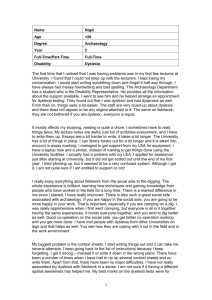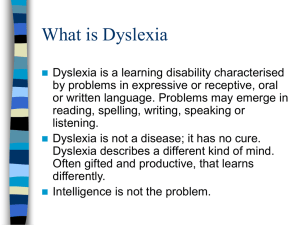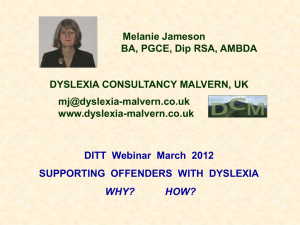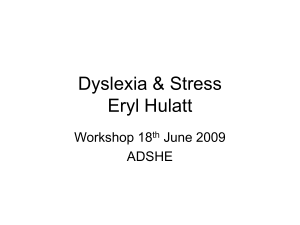Dyslexia and Final Exams
advertisement
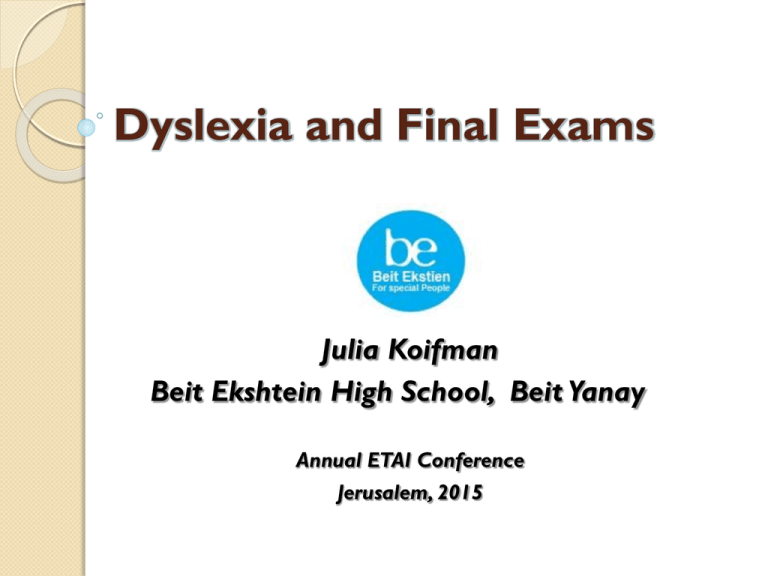
Dyslexia and Final Exams Julia Koifman Beit Ekshtein High School, Beit Yanay Annual ETAI Conference Jerusalem, 2015 Programme Introduction Recognizing LD Students Reading, Writing and Listening in LD Classes Technology in the Classroom Planning a Computer-Assisted lesson Final Exams and Accomodations Positive Aspects of Dyslexia Introduction https://www.youtube.com/watch?v=0XsJXyJWuzY Recognizing LD Students https://www.youtube.com/watch?v=IEpBujdee8M Behavior Hyperactive kids… are restless and chatty shout the answers before they hear the whole question Daydreamers… never make any troubles listen to the teacher but misunderstand the material They both are unfocused and do the tasks wrong. Writing They confuse letters They misspell words They make a lot of grammar and syntax mistakes Their sentences are short and noninformative Their compositions are too short and incoherent Their handwriting is unreadable Reading They can read but they don’t understand They often refuse to read aloud since they are afraid of making mistakes They mispronounce the words They read slowly and get exhausted While doing reading comprehension tasks they guess the answers Speaking and Listening Most of them understand spoken English They can speak English fluently While doing listening comprehension they understand the spoken text but misunderstand the questions They guess the answers or give up Aims of Special Education Schools To develop students' listening skills To develop their vocabulary To improve their spelling and grammar To develop their writing skills To improve teaching literary texts When Beit Ekshtein High Schools get new students every year, their tasks are: To identify their LD To appropriate diagnostic studies To help this population to succeed To enable them to realize their full potential To complete their studies successfully Computer-Assisted lessons in 11th -12th grades Research studies show that good computer software enhances learning in the less motivated student. Almost without exception, students enjoy the computer sessions. Kahoot Grammar and Vocabulary Reading and Listening Comprehension Literature https://getkahoot.com/ Literature in LD classes http://tlc.cet.ac.il/ The Road Not Taken https://www.youtube.com/watch?v=ebfcZTl-uys Rhyme and Spelling Teaching HOTS and LOTS http://www1.amalnet.k12.il/berseva/profession/English/literature%204%20poin ts/The%20Road%20Not%20Taken/The%20Road%20Not%20Taken.pdf Final Exam and Accomodations http://cms.education.gov.il/EducationCMS/Units/Mazkirut_Pedagogit/Englis h/Bagrut/LD/LD_+Guidelines.htm Testing Accommodation Authorized by the School LD committee. Authorized by the Regional LD committees. Extra time A, B, C, D, E, F, G Ignoring spelling errors A, B, C, D, E Use of an electronic dictionary A, B, C, D, E, F, G Text enlargement A, B, C, D, E, F, G Listening to a recording A, B, C, D, F E, G Recording answers A, B, C, D, E F,G Oral Examination: Listening to a recording + recording/typing answers on the computerized exam F, G A, B, C, D, E, F, G Positive Aspects of Dyslexia “Dyslexia affects only some skills and abilities, and is not linked to a person's general level of intelligence” Dyslexic people are highly creative thinkers who often solve problems through visual imagery. While the school years can be a difficult time for dyslexic learners, their exceptional gifts and talents have made them some of the most successful people in the world- outside the classroom. So while some people, at some times, may look at dyslexia as a disability, it really is a learning difference that is accompanied by some impressive strengths. Dyslexic Strengths Often highly creative Persistent Can easily grasp new concepts See patterns, connections and similarities that others don’t see Excellent at solving puzzles Holistic: they see the big picture, don’t get lost in details, get to the important aspects Excellent comprehension of stories read or told to them Strong reasoning skills Understand abstract ideas Inclination to think outside the box Dyslexic Careers Science/Research Marketing/Sales Design Woodworking/Carpentry Art Acting Architecture Engineering Photography Music Software design Sport Bibliography .1. Burani C, 2008. "Morpheme based reading aloud" http://www.eric.ed.gov/ERICWebPortal/search/detailmini.jsp?_nfpb=tru e&_&ERICExtSearch_SearchValue_0=EJ796533&ERICExtSearch_Searc hType_0=no&accno=EJ796533 2. Davis R.D., 1992. "37 Common Characteristics of Dyslexia". http://www.dyslexia.com/library/symptoms.htm 3. Goguadze T, 2005. "Signs of Dyslexia in Teenagers". Moscow State University, Russia. 4. Houk M.D., 2007. "Tips to Help Dyslexic Students". http://www.suite101.com/content/tips-to-help-dyslexic-studentsa34071 Thank you! Julia Koifman jkoifman@yandex.ru

